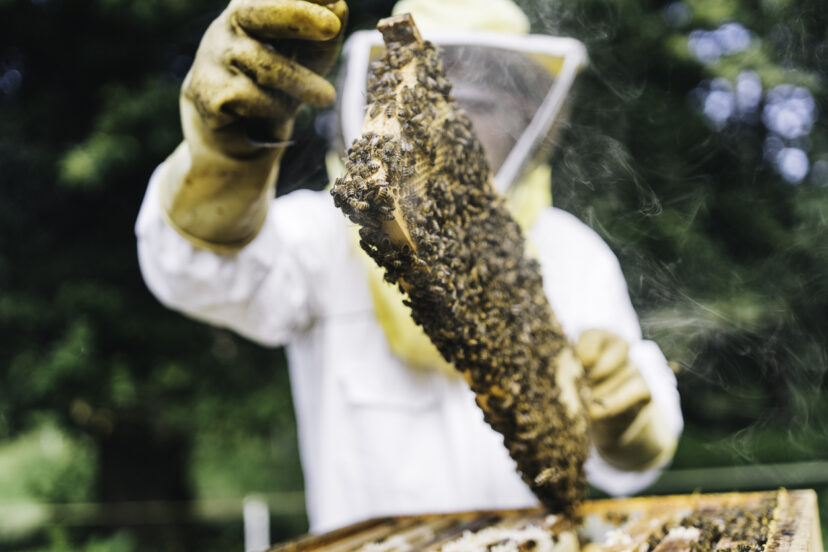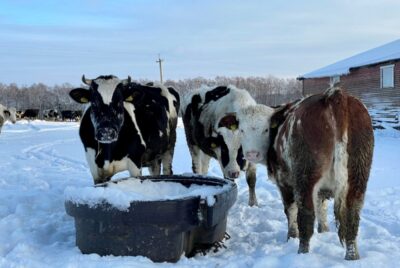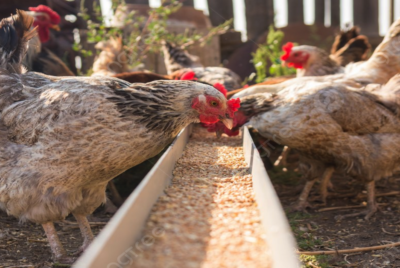My Passion for Beekeeping
"We may earn a commission from purchases made using our links. Please see disclaimer."
Exciting news! I am delighted to introduce Lindsey Chastain from The Waddle and Cluck as a guest contributor. Lindsey shares her expertise in Gardening, Homesteading, Livestock, and Recipes through her blog. Here is what she says about beekeeping.
How I First Became Fascinated with Bees
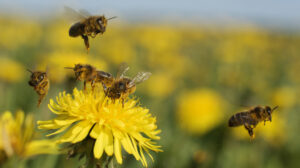 I’ve always loved gardening and growing my own fruits and vegetables. A few years ago, I became curious about pollination and how important bees are to my backyard crops. The more I learned about the vital role bees play in food production, the more fascinated I became. I started reading everything I could about bee biology and behavior.
I’ve always loved gardening and growing my own fruits and vegetables. A few years ago, I became curious about pollination and how important bees are to my backyard crops. The more I learned about the vital role bees play in food production, the more fascinated I became. I started reading everything I could about bee biology and behavior.
When a friend who kept hives let me observe a hive inspection, I was hooked. I knew I had to start my own beekeeping hobby.
Obtaining My First Colony and Hive
Once I decided to become a beekeeper, getting my first colony involved several steps:
Choosing the Right Location for My Hive
I found the perfect sunny, secluded spot at the edge of my property where the bees would have foraging flowers nearby but be far from foot traffic or neighbors. Having a water source in my garden was ideal. I made sure the location got morning sun to warm the hives quickly. The direction and exposure of the site were also important for getting ideal light and shelter from wind. After researching, I found the optimal placement.
Acquiring the Proper Beekeeping Equipment
I purchased a beginner’s setup of a Langstroth hive along with frames, a smoker, a hive tool, and protective gear. Having the right woodenware and accessories made getting started much easier. The local beekeeping store helped me assemble the perfect starter kit. I made sure to get high-quality materials that would last. The store owner gave me great advice as a beginner.
Selecting Docile Bee Breeds Appropriate for My Area
On the advice of my local beekeepers club, I decided on Italian honey bees known for their gentle nature and honey productivity. I wanted bees well suited for my colder climate. The Italians were a great match for my region. I liked that this breed was recommended for being easy to handle. After researching different options, the Italians seemed like the best fit.
Ordering Bees and a Queen
I ordered a 3-pound package of bees and a mated queen to install in early spring. Starting with these basic ingredients, I would build up my first colony. I was so excited to get the call that my bees had shipped. I ordered from a reputable apiary that had good reviews. Getting healthy bees was critical for starting off my colony on the right foot.
Caring for My New Bees
I was eager but anxious when my new bees arrived. Here is how I got my colony established:
Installing the Bees in Their New Home
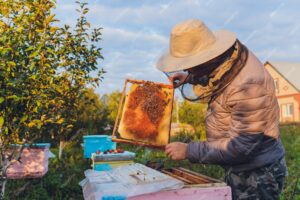 I shook the bees into the empty hive gently, placed the caged queen inside, and then added frames of foundation for them to build a comb on. It was magical seeing them start to settle in. Their buzzing was music to my ears. I took my time and followed the installation instructions carefully. Seeing the bees start fanning their wings to spread the queen’s pheromone was a good sign.
I shook the bees into the empty hive gently, placed the caged queen inside, and then added frames of foundation for them to build a comb on. It was magical seeing them start to settle in. Their buzzing was music to my ears. I took my time and followed the installation instructions carefully. Seeing the bees start fanning their wings to spread the queen’s pheromone was a good sign.
Feeding Sugar Syrup to Sustain the Colony
Until the bees could forage outside, I made sure to keep the feeder filled with sugar syrup to provide ample food. I used a 2:1 ratio of sugar to water for the syrup. Feeding them was crucial at first. I refilled the feeder often to make sure it never went empty. The bees would cluster around the feeder, sucking up the syrup.
Regular Hive Inspections and Maintenance
I enjoyed learning the rhythm of doing weekly inspections to monitor eggs, brood, queen health, and more. Keeping records helped me track their progress. Seeing the bees hard at work was so fascinating up close. I took pictures to document what I saw each week. Catching any issues early was important. I made sure not to disrupt the bees too much during inspections.
Adding Supers as the Colony Expands
As the hive population grew, I added more boxes with frames above to give them space. Seeing the bees draw out the comb was fascinating. The hive expanded faster than I expected! Once most frames were filled with brood or honey, I knew it was time to add another super. Having extra room prevented overcrowding.
Harvesting Honey and Beeswax
By late summer, I was rewarded with my first honey harvest:
Knowing When the Honey is Ready for Harvest
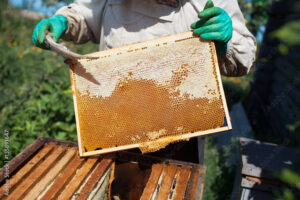
Once most frames were capped over with wax, I knew it was time to collect the excess honey stores. The bees’ hard work paid off! My mentor gave me tips on identifying ripe honey. I waited until late summer when the supers were filled and well-capped. Resisting the urge to harvest too early was difficult but important.
Extracting the Honey from the Frames
I borrowed an electric extractor to spin the honey out of the frames. The golden glow as it flowed out was so satisfying. The fresh honey smelled heavenly. I was careful not to damage the wax comb so it could be reused. Warming the frames slightly helped the honey flow more freely.
Bottling and Storing my Liquid Gold
After filtering, I carefully bottled the honey in sterilized mason jars. Having honey from my own hives was an amazing feeling. Filling those first jars was an unforgettable moment. I made sure to handle the honey gently to preserve the natural enzymes. The beautiful amber color of my honey was so enticing.
Harvesting Beeswax for Candles and Skincare
I rendered leftover comb into beeswax for candles, lotions, and lip balms. The aromatherapy benefits are wonderful. Collecting beeswax was a nice bonus product. I filtered the rendered wax and poured it into molds to make lovely candles. The beeswax smelled amazing and was great for moisturizing.
Overcoming Common Beekeeping Challenges
While rewarding, beekeeping did have some tricky learning curves:
Strategies to Prevent Swarming
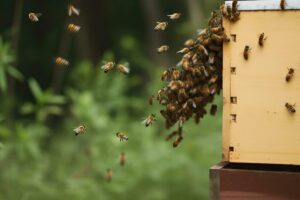
I inspect for swarm cells often and split robust hives to give colonies more space. Clipping the queen’s wings helps deter swarming. Staying vigilant is key to preventing swarming issues. When I did find swarm cells, I was able to divide the hive before swarming occurred. Having backup equipment helped with doing splits.
Identifying and Treating Pests and Diseases
I monitor for mites and treat them when needed. Keeping hives healthy overall is key to preventing diseases. Catching problems early makes treatment easier. Joining a bee club gave me good info on identifying diseases. I learned how to do sugar shake tests for varroa mites. Treating proactively ensured diseases did not get out of hand.
Coping with Colony Collapse Disorder
CCD is still a mystery but I try to reduce pesticide exposure and stress on the bees. Having backup hives provides insurance. Research is still needed to understand CCD. I make sure my bees have access to a variety of forage sources. Limiting migratory stress on the bees seems to help avoid CCD.
Winterizing my Hives
I insulate hives and make sure they have adequate food for the colder months when flowers are scarce. Tar paper wraps help regulate temperature. Feeding syrup helps bees bulk up before winter. I added insulation boxes around my hives in the fall to help maintain warmth. Monitoring food stores and supplementing with sugar syrup was important so they had enough reserves. On cold days, I made sure entrances were not blocked by dead bees or snow so ventilation was adequate. Checking on hives minimally during winter was necessary.
The Satisfactions of Being a Beekeeper
Despite some challenges, I’ve loved every minute of becoming a beekeeper. Working with these fascinating creatures never fails to amaze and inspire me. Seeing my backyard flow with life and activity thanks to my buzzing friends is profoundly gratifying. And of course, being able to harvest and share my homegrown honey has been utterly delicious! If you have any interest, I highly encourage you to look into beekeeping. Your patience and care will be rewarded with the sweets of their labor and the humble reminder that we are all interconnected in nature’s web.
Conclusion
Starting my beekeeping hobby has brought me immense joy and a sense of purpose. Despite initial hesitation about working with stinging insects, I’ve found beekeeping to be profoundly rewarding. With education, the right equipment, gentle bee breeds, and proper care you can become a successful backyard beekeeper. There are challenges to overcome, but being able to harvest your own honey makes it all worthwhile. If you love nature and growing your own food, give beekeeping a try! You may just get hooked by the magic of bees like I did.
FAQs
What’s the best way to start beekeeping as a beginner?
Take a class, join a beekeeping club, and read guides to educate yourself thoroughly first. Start with just one or two hives in your first year. Seek out an experienced local mentor.
How much space do I need for a beehive in my yard?
You can keep a couple of hives comfortably on less than half an acre. Hives should be spaced apart and given some flyway space in front. Make sure you follow local regulations.
What are the upfront costs for getting started with beekeeping?
The upfront investment to start beekeeping is approximately $500 to $1,000 – this includes the cost of woodenware, protective gear, bees and a queen, initial feeding supplies, and miscellaneous equipment. The first year has the highest cost as you purchase all the equipment, with lower ongoing yearly expenses just to maintain and replace hive components as needed. While not cheap, getting started in beekeeping is feasible for many hobbyists, and the reward of fresh honey makes the investment worthwhile.
What kinds of flowers should I plant to help my bee colonies?
Bees need a variety of flowering plants and trees to collect nectar and pollen from spring through fall. Some good options are clovers, lavenders, mints, sunflowers, milkweed, fruit trees, and anything in the aster or daisy family. Have a mix of plants that bloom in succession for season-long forage.
How can I get involved with other local beekeepers?
Joining a beekeeping association is a great way to take classes, get advice, and connect with mentors. Bee clubs often have meetings and events, and operate forums to share information. You can learn a lot from partnering with experienced beekeepers nearby.
Visit Homesteading Tips101 for more articles like this one.

